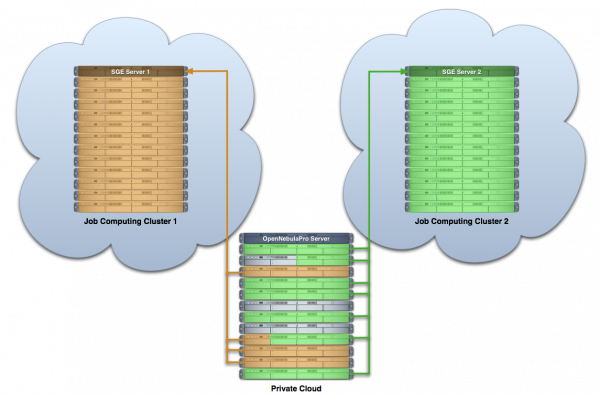Clouds for HPC and Science
OpenNebula is the most widely used cloud management platform to build high performance computing and science clouds for hosting virtualized computing and data processing environments and for providing users with new innovative “HPC as a service” resource provisioning models. These HPC optimized clouds provide access to flexible and elastic scientific and technical computing to solve complex problems and drive innovation in Science, Engineering, Manufacturing and Analytics.
What Are the Benefits of Building a HPC Cloud?
Cloud computing enables the execution of flexible and elastic cluster and high performance computing services on demand while reducing the associated cost of building the datacenter infrastructure. Transforming your computing cluster into a private cloud brings many benefits without requiring end users to change their applications:
- Support for heterogeneous execution environments with multiple, even conflicting, software requirements on the same shared cluster
- Faster delivery and scalability of computing services to meet dynamic demands of different computing clusters with automatic provision of computing worker nodes
- Faster respond to infrastructure needs for computing services with dynamic resizing of the physical infrastructure by adding new hosts, and dynamic cluster partitioning to meet capacity requirements of services
- Higher utilization of existing resources with the creation of a single larger infrastructure combining heterogeneous computing clusters, or infrastructure sharing between different departments managing their own production clusters, so removing application silos
- Operational saving with server consolidation to a reduced number of physical systems, so reducing space, administration effort, power and cooling requirements
- Lower infrastructure expenses by allowing “cloudbursting” with the combination of local computing resources withexternal commercial Cloud resources, so eliminating the over-purchase of systems to meet peaks demands
What Are Our Unique Functionalities to Build HPC Clouds?
Here we try to summarize the main requirements that we have received from organizations building clouds for HPC environments, and the functionalities that make OpenNebula unique to fulfill these requirements:
- Support for Automatic and Elastic Management of the Computing Service. The powerful CLI and APIs exposed by OpenNebula enable its easy integration with any of the most common job management systems (Torque, Open Grid Engine, Platform LSF…) to automatically provision computing worker nodes to meet dynamic demands. The advanced contextualization mechanisms enable the automatic configuration of the worker nodes.
- Combination of Physical and Virtual Resources. You can use OpenNebula for the management of the virtual worker nodes in your computer cluster and keep physical resources for HPC performance-sensitive applications that require high-bandwidth, low-latency interconnection networks.
- Management of Several Physical Clusters with Different Configurations. The multiple-zone functionality enables the management of multiple physical clusters with specific architecture and software/hardware execution environments to fulfill the needs from different workload profiles.
- Support for Several VOs. The new functionality to on-demand provision of Virtual Data Centers can be used to provide different VOs with isolated compartments of the cloud infrastructure.
- Support for Heterogeneous Execution Environments. The new repositories for VM appliances and templates can be used to provide users with pre-defined application environments. The fined-grain access control supports the creation and easy maintenance of the appliance repositories, that could be even private for different Virtual Data Centers (VOs).
- Full Isolation of Execution for Performance-sensitive Applications: The functionality for automatic placement of VMs and the configurable monitoring system enable the ability to define isolation levels for the computing services. The new multiple-zone support extends this functionality to easily manage fully isolated physical clusters.
- Execution of Complete Computing Clusters: You can deploy multi-tier services consisting of groups of inter-connected VMs and define their auto-configuration at boot time.
- Cloudbursting to Meet Peak Demands: The hybrid cloud functionality enables the deployment of architectures for cloudbursting to address peak or fluctuating demands of HTC (High Throughput Computing) workloads.
- Management of Persistent Scientific Data: You can make disks persistent, save changes for subsequent new executions, and share the new disks with other users in your Virtual Data Center (VO).
- Placement of VMs Near the Input Data: OpenNebula’s scheduler provides automatic VM placement for the definition of workload and resource-aware allocation policies such as packing, striping, load-aware, or affinity-aware.
- Ensure that each Tenant Gets a Fair Share of Resources: OpenNebula’s resource quota management helps allocate, track and limit resource utilization.

